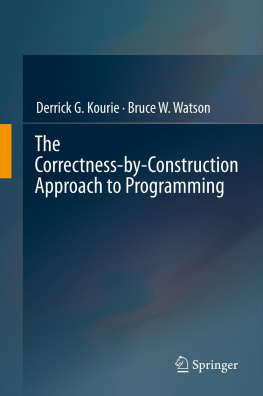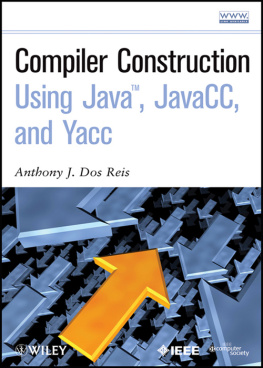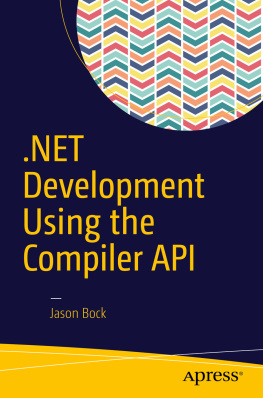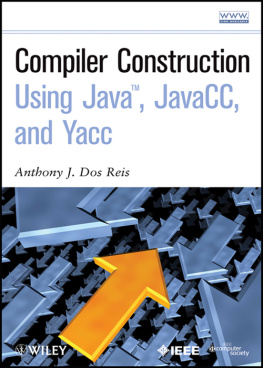Des Watson - A Practical Approach to Compiler Construction
Here you can read online Des Watson - A Practical Approach to Compiler Construction full text of the book (entire story) in english for free. Download pdf and epub, get meaning, cover and reviews about this ebook. City: Cham, publisher: Springer International Publishing, genre: Home and family. Description of the work, (preface) as well as reviews are available. Best literature library LitArk.com created for fans of good reading and offers a wide selection of genres:
Romance novel
Science fiction
Adventure
Detective
Science
History
Home and family
Prose
Art
Politics
Computer
Non-fiction
Religion
Business
Children
Humor
Choose a favorite category and find really read worthwhile books. Enjoy immersion in the world of imagination, feel the emotions of the characters or learn something new for yourself, make an fascinating discovery.
- Book:A Practical Approach to Compiler Construction
- Author:
- Publisher:Springer International Publishing
- Genre:
- City:Cham
- Rating:4 / 5
- Favourites:Add to favourites
- Your mark:
- 80
- 1
- 2
- 3
- 4
- 5
A Practical Approach to Compiler Construction: summary, description and annotation
We offer to read an annotation, description, summary or preface (depends on what the author of the book "A Practical Approach to Compiler Construction" wrote himself). If you haven't found the necessary information about the book — write in the comments, we will try to find it.
Des Watson: author's other books
Who wrote A Practical Approach to Compiler Construction? Find out the surname, the name of the author of the book and a list of all author's works by series.
A Practical Approach to Compiler Construction — read online for free the complete book (whole text) full work
Below is the text of the book, divided by pages. System saving the place of the last page read, allows you to conveniently read the book "A Practical Approach to Compiler Construction" online for free, without having to search again every time where you left off. Put a bookmark, and you can go to the page where you finished reading at any time.
Font size:
Interval:
Bookmark:
- Problem solving is significantly faster. Moving from the problem specification to code is simpler using a high-level language. Debugging high-level language code is much easier. Some high-level languages are suited to rapid prototyping, making it particularly easy to try out new ideas and add debugging code.
- High-level language programs are generally easier to read, understand and hence maintain. Maintenance of code is now a huge industry where programmers are modifying code unlikely to have been written by themselves. High-level language programs can be made, at least to some extent, self-documenting, reducing the need for profuse comments and separate documentation. The reader of the code is not overwhelmed by the detail necessary in low-level language programs.
- High-level languages are easier to learn.
- High-level language programs can be structured more easily to reflect the structure of the original problem. Most current high-level languages support a wide range of program and data structuring features such as object orientation, support for asynchronous processes and parallelism.
- High-level languages can offer software portability. This demands some degree of language standardisation. Most high-level languages are now fairly tightly defined so that, for example, moving a Java program from one machine to another with different architectures and operating systems should be an easy task.
- Compile-time checking can remove many bugs at an early stage, before the program actually runs. Checking variable declarations, type checking, ensuring that variables are properly initialised, checking for compatibility in function arguments and so on are often supported by high-level languages. Furthermore, the compiler can insert runtime code such as array bound checking. The small additional runtime cost may be a small price to pay for early removal of errors.
- The program may need to perform some low-level, hardware-specific operations which do not correspond to a high-level language feature. For example, the hardware may store device status information in a particular storage locationin most high-level languages there is no way to express direct machine addressing. There may be a need to perform low-level i/o, or make use of a specific machine instruction, again probably difficult to express in a high-level language.
- The use of low-level languages is often justified on the grounds of efficiency in terms of execution speed or runtime storage requirements. This is an important issue and is discussed later in this section.
Font size:
Interval:
Bookmark:
Similar books «A Practical Approach to Compiler Construction»
Look at similar books to A Practical Approach to Compiler Construction. We have selected literature similar in name and meaning in the hope of providing readers with more options to find new, interesting, not yet read works.
Discussion, reviews of the book A Practical Approach to Compiler Construction and just readers' own opinions. Leave your comments, write what you think about the work, its meaning or the main characters. Specify what exactly you liked and what you didn't like, and why you think so.









